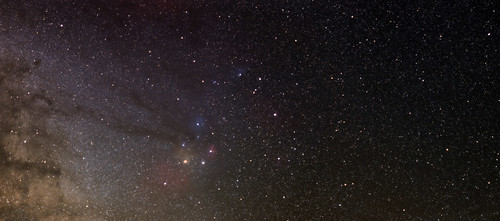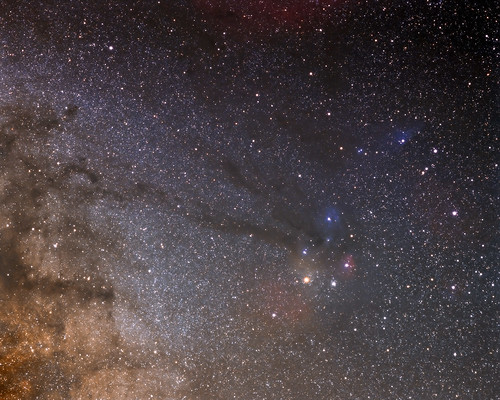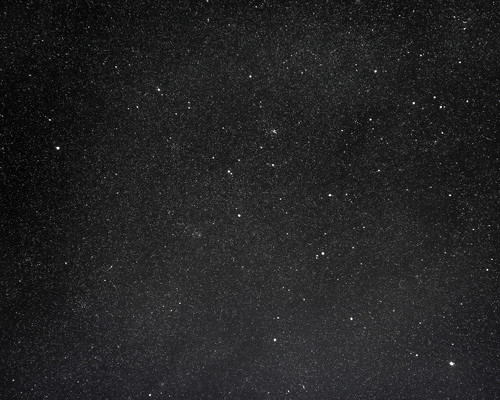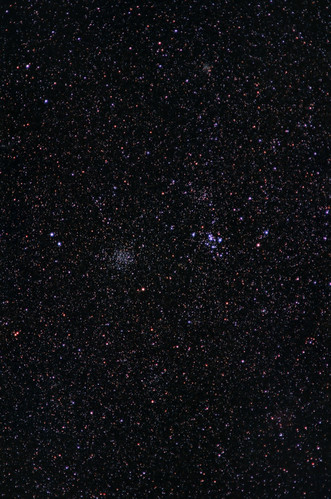On the same morning while waiting for the Antares region to rise and clear the treeline, I decided to capture the region just west of the area. The same setup was used (165mm @ f/4.8 45 minutes exposure) to capture southern Libra. I had planned the sequence the night before. This mosaic is processed somewhat differently from the original post, trying to maintain the advantages of the film medium with subtle detail revealed. Autostitch was used to blend the two frames.
The next outing will try to form a four frame mosaic, which will include the same region represented here, plus two additional frames further east to include the Sagittarius region. Now that would be something wouldn't you say?
Notice how this frame details the Milky Way's central bulge tapering off into space and entering the galactic halo region, home of globular clusters. Can you spot globular cluster NGC-5897 in the right side of this image? Look sharp!
As it is horribly undersampled here, the minimum I recommend is here: dl.dropbox.com/u/59003880/pano1_PIX2_1280.jpg
Friday, April 20, 2012
Ophiuchus / Scorpius / Libra
Thursday, April 19, 2012
Ophiuchus / Scorpius Region
I'm back to exposing E200 again. Such a great film for astrophotography. Legendary at this point.
The region of Scorpius and Ophiuchus taken on an early morning on March 22. The detail is such that one will never tire of shooting this area.
Pentax 67 165mm f/2.8 @ f/4.8 45 minutes exposure on Kodak E200 Pushed +1.5 stops
Tuesday, April 17, 2012
Testing Kodak's TMAX 400 for Astrophotography
 |
| Two images, both taken with the Pentax 67 and 300mm f/4 lens using exposures of 15 and 30 minutes. |
Faint details of the Orion Nebula appear region show up well. The emission nebula NGC-1977 registered very well, owing to the films blue spectral sensitivity. I'm imagining galaxies would do well with this film.
 |
| A cropped section of the 30 minute exposure. |
This image of the Milky Way in Puppis clearly shows the benefit of T-Max to record faint stellar images. This film will do well for open star clusters and the star clouds of summer. When enlarged, the grain was remarkably tame. Halation was not a problem. The bright stars did produce overly sized spot images, but this was an aberration present in the lens used.
 |
| The Milky Way star fields of Puppis as revealed by TMAX 400. 300MM @ F/5.6 30 minutes exposure. |
Black and white astrophotography can still be done in the 21st century. I found the experience rewarding and I am looking forward to years of future work with films like T-Max 400.
Sunday, April 15, 2012
Puppis Milky Way
The rich starfields of Puppis are often neglected by northern hemisphere observers / photographers due to its southerly declination. This view here was captured just above my treeline at my home in eastern Maine.
I employed the use of my Pentax 67 medium format camera with a 300mm f/4 lens stopped down to f/5.6 and 30 minutes exposure on Kodak TMAX 400 black and white film. The camera was piggybacked onto an 8" SCT for guiding.
The negative was processed professionally in Kodak XTOL developer. It was then scanned by myself on an Epson V600 scanner. The image file was then imported into Photoshop for basic level adjustment and slight cropping.
Thursday, April 12, 2012
Film Test: Fujicolor Superia XTRA 400
Well as you may well know, over time film makers change back and forth film formulae that end up giving good Ha performance to poor Ha performance. The results here is somewhat mixed, I had expectations that it might be similar to Fuji's Fujicolor 100, also known as Superia 100, perhaps the best negative film for astrophotgraphy in recent history.
 |
| Three Exposures taken in February show comparitive exposures of 10, 20, and 40 minutes using a Pentax 67 and 105mm lens stopped down to f/4.8 |
 |
| The single 40 minute exposure of Orion |
A more promising result came with a frame taken on an early morning near the end of February. It was nice to visit with an old friend normally reserved for late spring. Note the good blue and yellow response as well as the good recording power revealing the dark streamers heading east. It is likely that this film could produce very pleasing results in the very bright regions of Sagittarius and Ophiuchus.
Thursday, April 5, 2012
Messier 46 and 47 in Puppis
Messier 46 and 47, a beautiful pair of clusters in Puppis, one relatively young, the other ancient. A fine view in Binoculars on a late winter or early spring evening.
Pentax Spotmatic II 300mm f/4 SMC Takumar @ f/4 30 minute exposure on Kodak Gold 100 film. Scanned on an Epson V600 scanner, imported into PixInsight for BDE and levels. Touched up in Photoshop.




